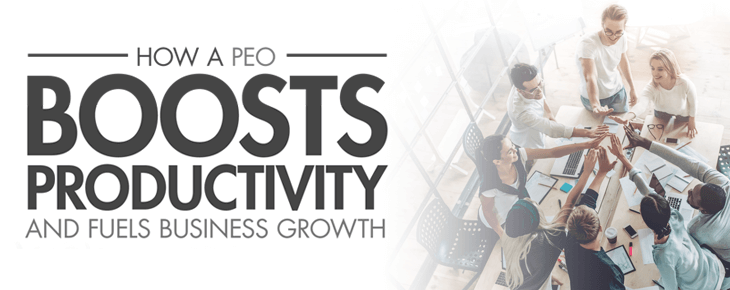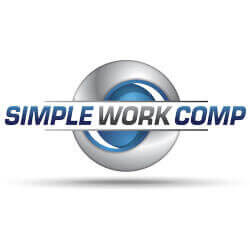
6 Benefits: How a PEO Boosts Productivity and Fuels Business Growth
[one_half]
1 – A PEO saves business owners money
2 – A PEO saves business owners time
3 – A PEO mitigates HR risk
4 – A PEO helps attract and retain employees
5 – A PEO makes offering benefits easy and affordable
6 – A PEO provides technology tools
Details below
[/one_half]
[one_half_last]
Looking for a PEO?
Have questions? Get help now?
1-866-684-5684
Speak with a real person and find out which PEO is right for you.
[/one_half_last]
Simple Work Comp is a no-cost PEO consulting firm with tailored PEO options for companies of all sizes. Contact us to get personalized help with choosing a PEO.
Responsibilities can mount for owners of growing businesses and, in areas like human resources, many of those responsibilities don’t align directly with core business functions. It can be very difficult and time-consuming to keep up with employment laws, manage HR risks and liability, handle payroll and payroll taxes and administer employee benefits—all while keeping up with the day-to-day needs of the business.
Outsourcing these functions to a Professional Employer Organization (PEO) frees up time for business owners to focus on customers and the success of the business. At the same time, PEOs help businesses compete for top talent by addressing employee needs for benefits and HR technology tools. Attracting and retaining great employees is harder than ever, in part because of low unemployment rates.
When businesses partner with a PEO, they gain the benefits of comprehensive HR resources to manage and mitigate risk, lower rates on workers’ compensation insurance, and relief from many of the administrative burdens of payroll and benefits administration. Employees enjoy convenient payroll options, mobile-friendly technology tools, and affordable benefits and discounts.
HERE ARE SIX WAYS EMPLOYERS WHO PARTNER WITH A PEO ARE ABLE TO BOOST PRODUCTIVITY AND FUEL BUSINESS GROWTH.
A PEO helps companies succeed by managing HR administration from onboarding through COBRA.
Studies conducted by the National Association of Professional Employer Organizations (NAPEO) show PEO clients have higher growth rates than other businesses and spend less money for more services and greater expertise in HR service administration.
1 A PEO Saves Business Owners Money
[accordion class=’accord6′]
On average, small business owners spend $7,000 per employee on regulations & tax compliance.
With a PEO’s purchasing power and bundled services, employers find partnering with a PEO often costs less than doing it alone or hiring the staff needed to cover all the bases. Here are just some of the ways a PEO saves business owners money:
[slide name=”WORKERS’ COMPENSATION”]
PEOs offer low rates and flexible payment plans with no big down payments, and there’s no need to submit to time-consuming and costly annual audits. A PEO also works with employers to manage workers’ compensation claim costs by reviewing bills to maximize savings opportunities and increase efficiency. PEO safety team members help clients identify hazards on job sites and create safety programs to mitigate risk.[/slide]
[slide name=”BENEFITS”]
Business owners can select a comprehensive benefits package at an affordable price and still offer their employees robust plans with lots of options. The PEO can also administer the benefits program, which ensures compliance with certain tax and regulatory reporting. Offering benefits allows clients to better attract and retain employees and spend less on turnover-related costs.
PEOs allow small businesses to improve productivity and profitability, to focus on their core missions and to grow. By providing payroll, benefits, hr services and assisting with compliance issues under state and federal law.
[/slide]
[slide name=”PAYROLL”]
Having payroll processed with a PEO means it will be accurate and on time. This can save business owners from expensive fees associated with payroll mistakes. A PEO also files federal and state taxes, which eliminates the risk of late fees or penalties. Employers realize further savings and convenience with flexible pay options like direct deposit or cash cards.
[/slide]
[slide name=”HR”]
The PEO’s team of HR experts provides guidance on employment practices, compliance, and procedures to help clients avoid costly lawsuits. Penalties can include back pay and benefits the victim should have earned, compensatory damages, punitive damages and liquidated damages. Sometimes, the cost of the case can be enough to put someone out of business.[/slide]
[/accordion]
2 A PEO Saves Business Owners Time
[accordion class=’accord2′]
On average, small business owners spend 25% of their time on paperwork.
Because a PEO offers HR expertise, processes payroll, manages insurance programs and administers employee benefits, clients have fewer HR challenges and more time to focus on strategy and business growth.
[slide name=”HR”]
With a PEO, business owners reduce the time they spend on paperwork and policies. PEOs provide a wealth of resources, including forms, policy outlines, employee handbooks, performance review templates and guidance on HR best practices. Responses to everyday HR issues or questions are prompt, so business owners can make decisions based on sound advice. Guiding business owners regarding their compliance with employment laws can save a great deal of time and expense. The PEO also processes unemployment claims and handles any needed communications.
[/slide]
[slide name=”PAYROLL”]
A PEO’s payroll services include processing even the most complex payrolls such as certified, multi-state, and payrolls organized to track job costs. The payroll team takes care of wage garnishments, withholdings, and tax withholding and filing so all clients have to do is complete the employee application process and track and enter employee hours. Technology tools make it easy for employers to onboard new employees and facilitate the approval of paid time off.
[/slide]
[slide name=”WORKERS’ COMPENSATION”]
Most workers’ compensation policies require an annual audit, which can take days if not weeks to complete. In a PEO partnership, business owners avoid that audit which saves quite a bit of time and hassle. When there is a claim, the PEO takes care of all the details in compliance with state rules and regulations. The PEO also prepares and submits OSHA reports annually on the client’s behalf.
When it comes to the injured worker, the PEO provides resources and support with a preferred provider network, case management and an established return-to-work program. If the PEO has a safety team, it can save employers time by reducing or identifying worksite accident causes and helping train employees.
[/slide]
[slide name=”EMPLOYEE BENEFITS”]
PEOs save the time it would take to develop an employee benefits program by offering clients a variety of packages. Joining the PEO’s master health plan or adopting any other available package is fast and easy. PEOs can even administer plans business owners may already have in place.
HERE ARE JUST SOME OF THE BENEFITS ADMINISTRATION SERVICES PEOS PROVIDE:
- Electronic enrollment eligibility notifications
- Life change and termination processing
- Carrier claims management
- Carrier renewal negotiations
- W-2 health premium reporting
- COBRA information processing
- Monthly carrier invoice reconciliation and payment
[/slide]
[/accordion]
3 A PEO Mitigates HR Risk
[accordion class=’accord1′]
When employment laws are mismanaged, there can be costly consequences.
[slide name=”EMPLOYMENT LAW COMPLIANCE”]
Federal, state and local regulations related to HR are more voluminous and complex than ever. Most businesses don’t have the staff or the in-depth subject matter expertise needed to adequately navigate wage and hour regulations and ensure compliance with the full range of employment and tax laws. When business owners partner with a PEO, they get a team of compliance experts who stay current with all the rules and regulations that apply to employers.
Here are three examples of federal laws that may apply to employers:
- FLSA (overtime, child labor, deductions from pay)
- FMLA (eligibility determination, confidential record-keeping, job protection and continuation of benefits)
- ADA (job descriptions that identify essential functions of the job, avoid unlawful interview questions, interactive process)
Here are some real examples of discrimination costs.
[one_third]
DISABILITY $7.1 MILLION

A jury awarded a discharged executive $7.1 million in damages after his employer fired him one day before his release from an outpatient rehabilitation program.
[/one_third]
[one_third]
ORIGIN $18 MILLION

A jury awarded four former managers of a convenience store chain more than $18 Million, accusing the chain of discrimination based on national origin.
[/one_third]
[one_third_last]
AGE $4.2 MILLION

A jury awarded a former claims adjuster $4.2 Million because age was determined to be a factor in his termination.
[/one_third_last]
A PEO also helps manage HR risk by helping clients:
- Create an employee handbook to include anti-discrimination and harassment policies.
- Familiarize themselves with wage and hour laws.
- Pay employees in accordance with the law.
- Pay employees in a timely manner.
[/slide]
[slide name=”INSURANCE COVERAGE EPLI AND WORKERS’ COMPENSATION”]
PEOs typically offer business owners a type of liability insurance called Employment Practices Liability Insurance (EPLI) to further guard employers from the significant costs associated with HR risk such as wrongful termination, discrimination, sexual harassment and retaliation. The policy may also provide coverage regarding defamation, failure to promote, negligent retention and deprivation of a career opportunity.
Employee lawsuits can be much more than just an inconvenience—they’re expensive. In 2017, there were more than 84,000 charges filed with the Equal Employment Opportunity Commission (EEOC). The majority of those charges stemmed from discrimination accusations based on race, sex and disability. Accusations of retaliation also amounted for a high percentage of the claims (48.8%). In all, more than $42 Million was awarded to plaintiffs who either settled or won their cases, but that doesn’t include legal costs that may have been incurred along the way. Even cases settled outside of court can cost $10,000-$50,000 and for some small and mid-sized businesses, that could be enough to put the company out of business.
For example:
[one_half]
[/one_half]
[one_half_last]
A 62-year-old Missouri woman filed an EEOC complaint because she believed her employer fired her because of her age. The matter settled for $55,000 and the employer’s attorney fees were $32,000. However, having EPLI coverage saved the employer a lot of money.
Instead of paying $87,000, he only paid $25,000 (the policy deductible).[/one_half_last]
In addition to EPLI, PEOs help businesses secure competitive rates for workers’ compensation insurance. That can sometimes be challenging for start-up companies, companies with past losses or those with high-risk jobs. PEOs have flexible workers’ compensation programs with more affordable rates than stand-alone policies and staff who help manage the cost of claims, coordinate return-to-work programs and recommend safety training.
ACCORDING TO OSHA, MORE THAN 5,000 WORKERS DIED ON THE JOB IN 2016 (THE MAJORITY IN CONSTRUCTION). THAT’S 14 DEATHS EVERY DAY.
Beyond the cost of workers’ compensation payments, medical expenses and costs for legal services, employers incur further costs from workplace accidents including training replacement employees, investigating the accident, implementing corrective measures, lost productivity, repairs of damaged equipment and property and costs associated with lower employee morale and absenteeism.
[/slide]
[/accordion]
4 A PEO Helps Attract and Retain Employees
[accordion class=’accord5′]
Employees of PEO clients more frequently described their company as competitive, innovative, enabling growth and delivering superior service.
[slide name=”BENEFITS MANAGEMENT”]
Employees are more likely to stay with a company when that company demonstrates a commitment to them as employees, has good hiring practices, has good HR policies and practices, has a comprehensive benefits package and provides them with training and development opportunities. A recent NAPEO study found that employees affiliated with a PEO had higher overall job satisfaction and considered their companies stronger because of the partnership. When asked to evaluate the quality of HR practices at their business, PEO client employees had stronger responses to the following statements than their peers in non-PEO firms:
The findings on the quality of HR practices, engagement and intent to stay suggest PEOs are able to help business owners create a better work environment by better HR management combined with an improved focus on business success drivers.
[/slide]
[/accordion]
5 A PEO Makes Offering Benefits Easy and Affordable
[accordion class=’accord4′]
PEO clients are able to offer their employees a comprehensive employee benefits package that includes retirement savings options, which helps attract and retain employees. PEO master policies are able to extend an affordable, flexible benefits package with options from top carriers.
[slide name=”BENEFITS MANAGEMENT”]
In addition to options like health insurance, voluntary benefits (dental, vision, disability) and supplemental plans (accident, cancer, hospital), adopting a PEO’s 401(k) plan frees clients from worrying about fiduciary responsibility, investment committees, maintaining plan documents, and performance of ADP/ACP/top heavy testing and plan audits. Employers can offer retirement savings with no out-of-pocket costs or elect to match a portion of employee contributions. This makes PEO-sponsored 401(k) plans very attractive for business owners from a cost and administrative perspective—just as much flexibility without all the cost.
PEOs administer benefit plans by enrolling and removing employees when necessary and answering any questions they might have. Benefits management includes taking care of life change updates like marriages or new family members, assisting with tax and regulatory reporting and ensuring the appropriate pre-tax deductions from employee paychecks.
Through a PEO, the employees of small businesses gain access to big-business employee benefits such as: 401(k) plans; health, dental, life and other insurance; medical savings accounts; and other benefits they might not typically receive as employees of a small company.
[/slide]
[/accordion]
6 A PEO Provides Technology Tools
[one_third]
[/one_third]
[two_thirds_last]
[accordion class=’accord3′]
PEOs provide clients with an online Human Resource Information System (HRIS) for easy access to employee records, time entry interfaces, benefits open enrollment sessions and reporting tools. Employers or administrators can enter payroll hours in the HRIS each pay period or rely on common integrations with time clock systems.
[slide name=”EMPLOYERS GET TO:”]
- Approve PTO requests.
- Oversee PTO rates and balances.
- Create or edit employee records.
- Hire or terminate employees.
- Manage performance reviews and corrective actions.
- Access forms and resources.
- Compile standard and advanced reports.
[/slide]
[slide name=”EMPLOYEES GET TO”]
- Manage personal information and direct deposit preferences.
- View and print W-2s or pay stubs.
- Request time off.
- View benefits and discount programs.
- View employer HR forms.
[/slide]
[/accordion]
[/two_thirds_last]
Simple Work Comp is a Florida-based PEO broker with nationwide coverage. Our PEO bundles services for payroll, HR and optional employee benefits with workers’ compensation insurance coverage to form a co-employment relationship. We aim to reduce workloads, improve HR and lower costs for our clients. The experience of one of our clients illustrates the value of partnering with Simple Work Comp.
Discover how Simple Work Comp can help your business cut costs, save time and focus on your business instead of HR by scheduling a Free Consultation.
